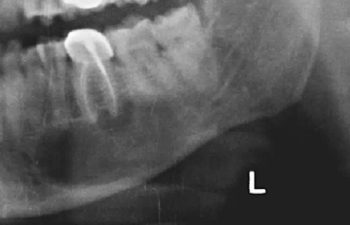
27-year-old woman referred by her general dentist for evaluation of an incidental finding for a periapical radiolucency . The patient reports to have had a prior RCT on #19 several years prior.
On physical exam the there was no buccal or lingual expansion of the jaw, teeth were not mobile, tooth #20 with lingering cold sensitivity, and area not tender to palpation.
Panoramic radiograph revealed a well-defined radiolucent lesion extending apically from tooth #21 to #18. The cyst displaced the inferior alveolar nerve inferiorly. The inferior cortex of the mandible is intact, along with no perforation of the buccal and lingual cortices. With IV sedation the patient was prepared for biopsy of the lesion. The biopsy returned as periapical granuloma.
Periapical Granuloma: The most common cyst of the jaw, found at the root apices of involved teeth. Pulpal necrosis with an ensuing infection stimulates the cell rests of Malassez to form a cyst. At times if a tooth is extracted and the apices are not thoroughly curretaged the remaining inflammatory tissue can form a cyst, evolving into a residual cyst.
Differential Diagnosis
- Periapical granuloma/radicular cyst
- Traumatic bone cyst
- Periapical scar
Treatment includes removal of the necrotic pulp either with RC T or extraction and enucleation of tooth. As with this patient extraction of the offending tooth and enucleation of the entire cyst was the modality of the treatment.
Posted on behalf of
23451 Madison St #120
Torrance, CA 90505
Phone: (310) 373-0667
Monday - Friday 8AM - 5PM
